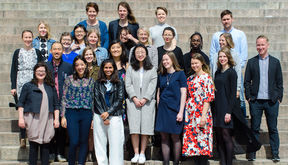Design For Government raised interest in the EU Design Days 2017

DFG is an advanced studio course where Master’s students of Aalto University aim to solve the challenges of various ministries' practices, guidelines and operations together with ministerial representatives to make policy level proposals. On the DfG course, design is seen as a strategic tool that can be used in decision-making. The course was presented at the sixth EU Design Days by course founder Seungho Lee and alumni of DFG’17 Emilija Veselova. During the annual two-day event participants from all over the EU together explore the next agendas for design by sharing exemplary projects from different regions on the practical and strategic roles of design. Lee and Veselova told Aalto communications about their refelections of the Brussels event.
Within the European Union, design is increasingly in focus when tackling with complex challenges of the present time. Aalto University, and Finland in general, on their part are paving the way for more formalised practices and education on design for public services and policy-making - which the DfG is a model example of. In the EU Design Days, Lee and Veselova presented DFG and its approach in addressing various systemic, state-level challenges through design approaches. They zoomed into few concrete examples, including the “Civil Servant 2.0” from 2016 to explain how both empathic and systemic understanding of the context are utilised during the course to propose concrete, bold solutions.
“Our presentation seems to have raised many questions and comments. Many from the audience seemed to be positively surprised to see such engagements between educational institution and ministerial offices, and the degree of complexities we deal with in DFG”, tell Lee and Veselova. The DfG course has been run every year since 2013 and so far the cooperation has involved six different ministries. 90 students from 23 countries have taken the course, and many of them are currently working within governments or for leading service design consultancies carrying out design projects for public-sector organisations in Finland and elsewhere.
Initiatives for better design
The opening panel of the EU Design Days was a thought provoking discussion with Policy Analyst at European Political Strategy Centre (EPSC) Saïd El Khadraoui; Assistant Professor in industrial design at the Eindhoven University of Technology (TU/e) Rens Brankaert and the current Vice-President of Bureau of European Design Associations (BEDA) Päivi Tahkokallio. The panelists discussed diverse issues including the future of mobility, massive immigration, and polarised politics of today from the different perspectives. El Khadraoui focused on the uncertainties of the innovation drivers for European Union in the context of sustainable development and EU policy. Tahkokallio concentrated on fostering design as an approach to provide vision and explore opportunities. The panelists were unanimous on these challenges being of systemic nature, and thus gathering diverse people around the table, to start a candid conversation with strong vision is the first step to understand the challenges.
There was also a pecha-kucha event, in which eight innovative initiatives from different regions of EU were presented. One of the projects came from “Captain Ludd”, an interdisciplinary design association in France that works on urban regeneration projects. Captain Ludd asks: How can we imagine the evolutions of an area with time? How can we involve the inhabitants in these transformations? How to imagine the future without planning heavy structures? Another interesting project presented in the event was “Beleef de Vestdijk”, an initiative of the city of Eindhoven to revive a car-focused central street into a pedestrian and cyclist friendly space. The air pollution in the street was exceeding the EU regulations and thus the traffic had to be reduced significantly. Eindhoven city council invited designers to envision potential changes, raise awareness about the project and to facilitate the experiment with the residents. The initiative resulted in cutting down two traffic lanes and using the space for other, greener purposes suggested by the inhabitants.
The two-days event left Lee and Veselova with assurance that design is increasingly dealing with more fundamental challenges of the society today. Yet they believe there should be more critical discussions within the design community about the abilities of designers, and how future of design education should look like. “EU Design Days was one such event where some of these issues were discussed, but we need much more discussion on this in both academic and professional communities. Further, we think this kind of discussions should travel beyond design community – towards civil society, government offices around the world, and intergovernmental organisations.”
EU Design Days was organised by a cooperation between the European Regions Research and Innovation Network (ERRIN), 15 ERRIN regions, Dutch Design Foundation (DDF), the Bureau of European Design Associations (BEDA) and the city of Eindhoven, and took place in the Brussels Fashion and Design Platform (MAD) building.
The multidisciplinary teaching team of Design for Government includes course responsible professor Ramia Mazé, course founder Seungho Lee, architect and designer Hella Hernberg, senior service designer, lecturer Juha Kronqvist and consultant Taneli Heinonen.
Contact:
Professor, New Frontiers in Design Ramia Mazé, Aalto University School of Arts, Design and Architecture, tel. 358 (0)504010030, [email protected]
Read more:
DfG blog written by Seungho Lee and Emilija Veselova: http://dfg-course.aalto.fi/2017/dfg-in-the-eu-design-days-2017/
DfG 2017: http://dfg-course.aalto.fi/2017/2017-final-show-in-videos-slides-and-pictures/
- Published:
- Updated:
Read more news

HRH Princess Maha Chakri Sirindhorn of Thailand visited Aalto University
During the visit, HRH and her delegation met with Aalto students and explored various activities.Summmer break in HR service point and new opening hours starting from 6 August 2024
HR service point is closed on 28 June - 5 August 2024. New opening hours are tuesday - thursday at 12.00 - 15.00 starting from 6 August 2024.Please note that the opening hours will change starting from 6 August 2024.

68 doctors, five honorary doctors - see photos from the conferment of Doctoral Degrees in Technology
The Ceremonial Conferment of Doctoral Degrees in Technology 2024 took place on Friday 14 June at Dipoli.